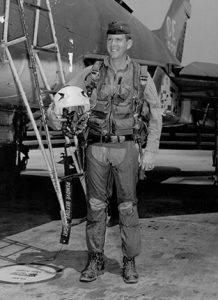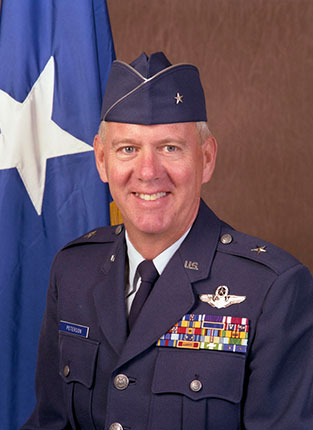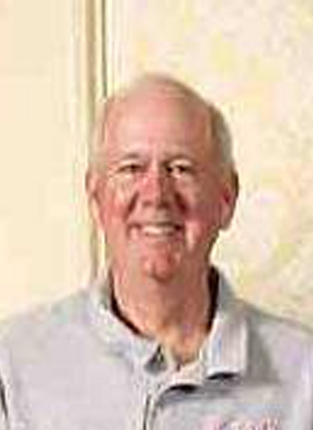Ken Peterson was born 20 May 1944 in Detroit, MI, to a WWII Army Major and a mostly stay-at-home-Mom who also taught at Vassar College. He grew up just across the Hudson River from West Point, N.Y., and in Gilmanton Iron Works, NH. Ken received a degree in engineering and a commission as a 2Lt. from Penn State University in 1966.
He received the Flying Training Award in his UPT class 67-G at Moody AFB and was Top Gun of his F-100 CCTS at Cannon AFB, NM. After flying 212 missions in the F-100 in Viet Nam, he converted to the F-101 and graduated first in his class. It was a short-lived tour at Suffolk County AFB, as they soon transferred their F-101s to the Bangor, Maine, Air National Guard. Ken finished his extended active duty assignment as a dual-qualified instructor functional check pilot in the T-37 and T-38 at Craig AFB, AL.
He joined the Guard at Otis Air National Guard Base in 1971 flying the F-100 and transitioned to the F-106 in 1972. He was hired by Eastern Air Lines in 1973. He and hundreds of other Eastern pilots were furloughed in 1974 for the next 4 years. Ken “worked full time for part-time pay” at the Guard for those intervening years, performing IP/FE/FCF duties and earning a Master of Air Defense rating in the F-106. From 1978 to 1990 Ken flew for both Eastern and the Air Guard competing as a team captain and team leader in three William Tell World Wide Weapons meets, sitting air defense alert, and flying his own LA-4 Lake Amphibian.
In 1979 he married Susan (Kennedy) Peterson and they have two children. In 1987 his unit converted to the F-15A/B, and in 1990 when Eastern terminated service Ken went back full time with the Guard. His final military assignment was as the Commander, 102 Fighter Wing, Otis ANGB as an O-7. While commanding at Otis he was responsible for a 22,000-acre military reservation with 19 tenant organizations, including Army National Guard and U.S. Coast Guard flying units in addition to his own F-15 Fighter Wing. Ken was fully qualified in the F-15 throughout his command. In 1997 he retired from the military having flown fighter aircraft for 30 years, and joined Delta Air Lines, retiring as a Captain in 2004.
He maintains an aviation safety consulting business, helps his wife, Dr. Susan K. Peterson, and her educational consulting business, and helps to move their two USAF officer children and USAF officer son-in-law about the country/world when needed. Daughter (Lt. Col. Erin Peterson Hayde) is a USAF Weapons School Distinguished Graduate, was a Weapons School instructor and is currently the Executive Officer to the 12th AF/CC. Her husband (Lt. Col. Ryan T. Hayde) was a Distinguished Graduate and A-10 IP at the USAF Weapons School and is now the 354FS/CC. Son (Capt. Adam K. Peterson) is a UPT Distinguished Graduate, Top Gun graduate of his F-15E Course and Red River Rat awardee and Top Gun of his first deployment from Lakenheath to Tyndall AFB to live fire. He is currently matriculating at the USAF Weapons School.
Ken believes in community service. In his retirement years, he has served as an elected member of the NH House of Representatives and as an elected Town Councilor in Bedford, NH. He also serves as the elected Chair of the Trustees of the Trust funds of Bedford, NH and has been a member of the Town Safety Committee for 15 years
 Ken Peterson – Caterpillar Story
Ken Peterson – Caterpillar Story
02 Apr 1968. Vietnam. CAS, troops in contact, restricted run in heading, multiple low-level passes over the same target area, moderate small arms fire. The odds shifted in favor of the golden BB, and soon the engine was no longer sucking and blowing. The cockpit indicator lights offered a red dominated multi-colored display that was diffused by a surreal hazy smoke. No time to attempt to fix things, so it was move on. Zoomed, got ready to boom and told the flight lead (Capt. Mick Doty) I was going to need alternate transportation home (or words to that effect). Assumed the position, pulled the handles and — nothing.
Nuts, how does that manual bailout procedure work again? Then slowly—ever so slowly—the canopy began to slide aft and up, and it left the jet. Step one complete. Squeezed the triggers. Again, nothing. Man, this is not my day. Okay, actuate the bailout bottle, disconnect the personal leads, trim nose down, invert the jet, unfasten the lap belt/push free and then pull the D-ring. But first, try one more squeeze—lo and behold, the seat started up the rails. The fire-spewing dragon pushed me out (up? sideways? down?). Now, of course, all who have “been there and done that” realize the truth—everything worked as it should, in well under a second, but temporal distortion was giving me the (very) slow-motion version of the movie.
As the seat and I tumbled through the air, the belt release mechanism fired, and the butt snapper did its thing. Now the (streaming) chute appeared between the legs (between the legs??). Wonder what it is going feel like when it —–Man, what a crack-the-whip.
Checked the chute, prepared for the four-line cut—-more nuts. Three panels were shredded, and the ejection seat was sitting on top of the chute. So instead of an umbrella, I had a Dolly Parton. Skipped the four-line cut and tried to shake the seat off the canopy. Nearly collapsed ½ the remaining chute, so abandoned that plan. Got ready to land (soon). Notwithstanding the bullets whizzing all around, I figured at least the rice paddy was bound to be soft. Yeah, soft like a concrete parking lot.
Fortunately, I didn’t know at the time how fast I was coming down with the damaged chute et al., or I might have really been scared. Crash. The PLF was more of a PFL (Poor Freakin’ Landing).
The ejection seat landed very soon thereafter—on my head. Dazed and with a cracked helmet, I figured I might still have to take on Charlie, so I drew my trusty USAF .38 revolver which was coolly strapped to my hip in the best John Wayne holster ever seen. Gunfire was inbound from seemingly every direction.
It wasn’t too long before I heard the greatest sound every downed pilot hopes for—WHAP, WHAP, WHAP. The good guys were in range. Two Hueys approached, one hovering to pick me up, the other laying down suppression fire that would have made Rambo proud. I crawled over to and got in the lead Huey, gave a thumbs up to the AC, and waited for liftoff. Nothing. I gave him another thumbs-up, and he just pointed over my shoulder, outside the chopper. Being in the relatively safe confines of the Huey and not in the best of condition, I was reluctant to get back out and request official permission to board, so I hesitated. The “crusty old chopper AC” (at least 30 years old), threw his hands up in the air, unbuckled, and got out. Meanwhile, the co-pilot maintained a hover while the two 19-year-old kids [“Guts” on the left side and “More Guts” on the right] were spewing out automatic fire at the very unfriendly tree lines.
The AC strolled around, picked up my chute and life raft (there had been a possibility of landing in a river), plus the ejection seat (I couldn’t convince him it was a no deposit, no return item), placed it all next to me (directing me to hold on to it), strapped himself back in, and off we went.
The ride back to Bien Hoa was exhilarating, to say the least. The heli guys figured that the lower and faster (we are talking chopper faster here) the better, to create less exposure to the always possible ground fire. We were nearly clipping the treetops along the way. I was picturing the curved up leading portion of the landing skid snagging a tree branch, and all of us winding upside down in another rice paddy. Midway home, the AC asked in a very polite, non-profane, unsarcastic tone, if it would be possible for me to turn off my ELT so the rest of them could continue to fight the *&^%$# war. The terrific hospital personnel cleaned up the blood on the upper torso and the brown stuff on the lower torso, and much later, the Buzzard [510th TFS] fighter pilot bar provided additional antiseptic.
— Ken Peterson


















